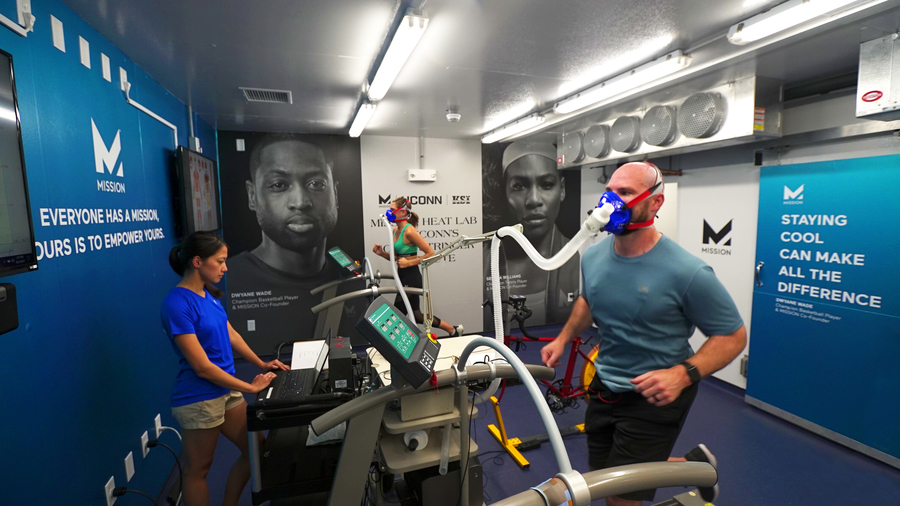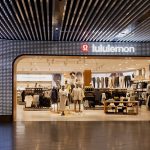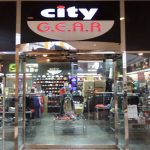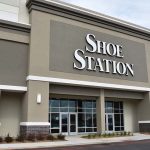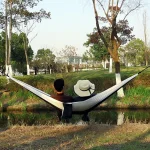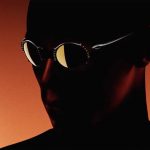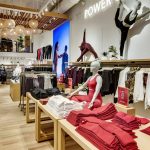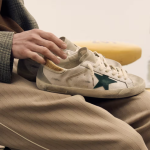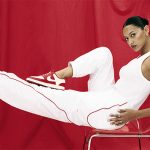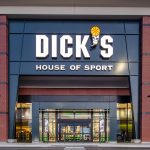Doubling its commitment to cooling technologies and its mission around preventing heat illness, Mission has signed on as the title sponsor of what’s being hailed as the nation’s premier academic heat research lab.
The Mission Heat Lab, which officially opened on September 22, represents a partnership with the Korey Stringer Institute (KSI) and is located at the University of Connecticut’s main campus in Storrs, CT. Named after the Minnesota Vikings lineman who became the first NFL player to die from exertional heat stroke in 2001, KSI is the nation’s leading sports safety research and advocacy organization specializing in heat illness research.
In an interview with SGB, Josh Shaw, founder and CEO of Mission, said Mission first signed on as a sponsor of KSI about four years ago. The partnership came about from a suggestion at the time from the head of Gatorade while at an event featuring Dwayne Wade, Mission’s star athlete.
Working closely with KSI in ensuing years, Mission became the first company that the institute reached out to in 2012 when it decided it needed to establish a bigger, world-class facility on UConn’s campus to explore new ways to improve human performance, endurance, and safety in the heat.
“We told the guys at KSI that this is literally the epitome of standing for something and putting your money where your mouth is,” said Shaw. “If we’re going to continue to be the leaders of the cooling revolution, this is a great statement for the market.”
UConn Professor Douglas Casa, a national expert on heat stroke and CEO of the Korey Stringer Institute, told SGB that KSI partnered with Mission because they’re “emerging as a critical force in the whole thermoregulatory space.”
Mission made the largest single private donation as part of its multi-year commitment. Other donors also stepped up with UConn matching those donations dollar for dollar.
The new lab is 650 square feet, including about 450 square feet of thermoregulatory-controlled space. It replaces a 100 square foot facility used for research previously.
But the vast equipment upgrade is the bigger deal. Research in the former facility was “very limited” because it largely relied on a few 25-year dehumidifiers. The new lab’s high-end exercise bikes and treadmills features a full suite of continuous physiological monitoring systems able to capture a test subject’s heart rate, internal temperature, skin temperature and other vital signs hundreds of times per second
Specifically, the lab is able to control temperature between 40 and 110 degrees Fahrenheit and humidity between 20 percent and 90 percent. Radiant heat panels will be installed later this year to measure the impact of the sun to further the lab’s ability to simulate any environment, from a cloudy 70-degree day with 40 percent humidity to a stifling hours-long military march in 100-degree heat under hot sun with 90-percent humidity. Said Casa, “Any possible combination, even variations of wind, we can create.”
The test chamber also includes restroom facilities and resting areas designed to allow test subjects to remain in a designated environment for hours at a time without the need for outside breaks that might skew data regarding how their body is reacting to conditions.
For Mission, one major benefit is branding rights. The lab is heavily-logoed with the Mission name as well as images of many of its athletes, including Serena Williams, Dwayne Wade, Carli Lloyd, and David Villa. Many of its ambassadors have also invested in the company. Any of Mission’s sponsored athletes can also visit the lab to test how their bodies manage handle heat-related stress and conditions.
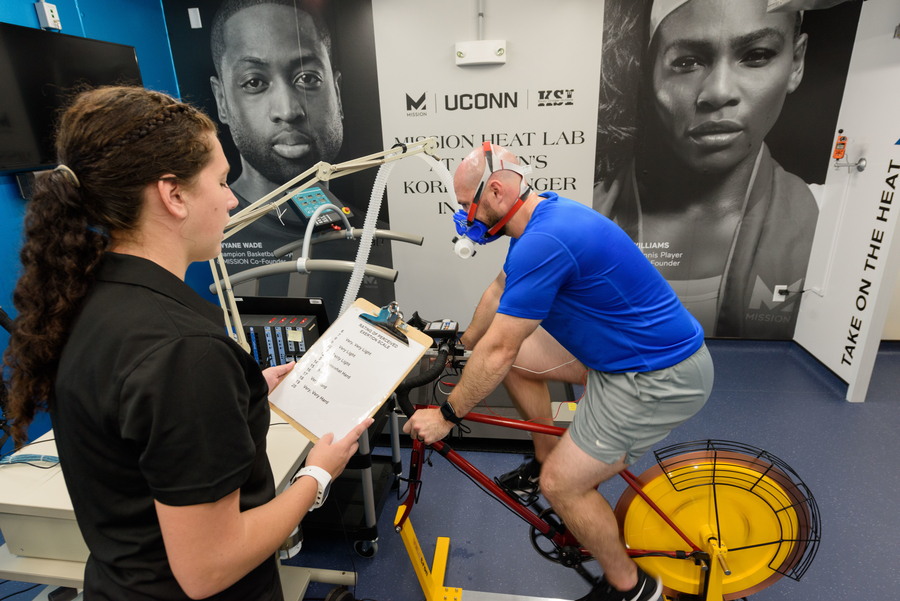
Gabrielle Giersch, a Ph.D. student and KSI assistant director of athlete performance and safety, looks on while Ryan Curtis, a Ph.D. student and KSI associate director of athlete performance and safety, rides an exercise bicycle at the Mission Heat Lab at the Korey Stringer Institute at Gampel Pavilion on Sept. 21, 2017. (Peter Morenus/UConn Photo)
Mission will also be able to test products. Said Shaw, “We have a very full pipeline over the next three years of technologies – everything from soft goods to hard goods. This laboratory and the ability for it to simulate heat and cool and humidity high and low in different settings really creates a great environment for us to put these products through field tests before we go to market.”
More broadly, the lab is expected to spark further innovation around thermoregulation technologies across many fields to assist not only athletes but workers and soldiers who also often manage distressful heat conditions.
Indeed, the Mission Heat Lab will be available for use by outside companies and organizations to maximize research opportunities in heat safety awareness as well as other areas of temperature-related studies. Beyond apparel, the lab is expected to be offer better insights into beverages as well as wearables. Said Shaw, “It’s going to be used to really further all elements related to heat safety.”
The lab naming rights comes as Mission continues to find success with the high-tech cooling towels its best known for. The third-generation of its cooling technologies, Mission Hyperactive Max, was introduced earlier this year and three more generations are heading for patent to support introductions in coming years. Cooling accessories also includes hats, head bands and other items. Said Shaw, “The cooling accessories continue to be the shining star for us but we’re surrounding it with some really smart technology.”
Mission has also found success with the launch earlier this year of its first apparel line, initially through Amazon. Said Shaw, “I can confidently say the smartest move we made was partnering with Amazon. They’ve been excellent partners and have surpassed all of our expectations in terms of media and marketing support.”
Shaw also welcomed Nike’s recent decision to sell directly on Amazon, believing Nike will “bring a lot of good power to the platform and bring more awareness. We’ll be happy to garner some of that attention and market share for sure.”
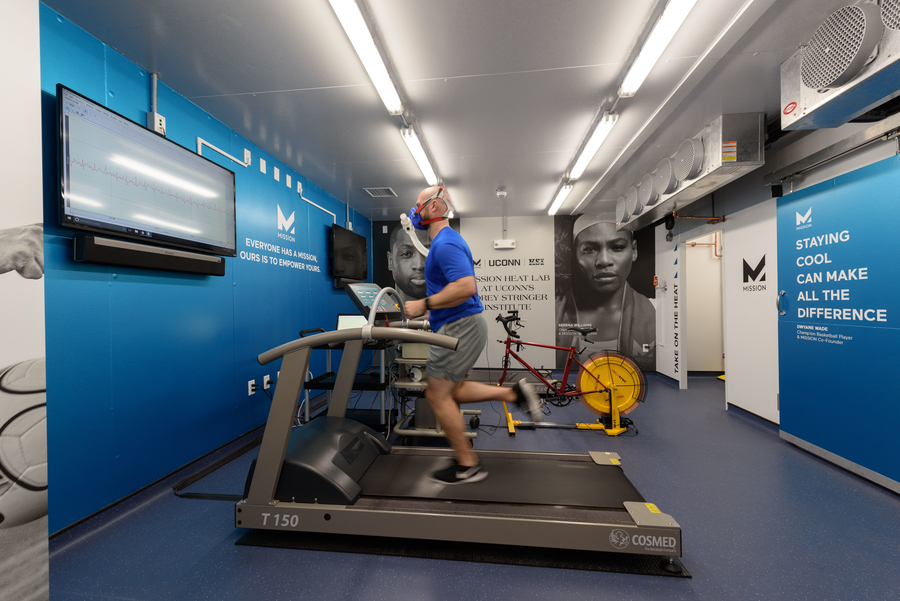
Ryan Curtis, KSI associate director of athlete performance and safety, runs on a treadmill at the Mission Heat Lab at the Korey Stringer Institute at Gampel Pavilion on Sept. 21, 2017. (Peter Morenus/UConn Photo)
Mission also eventually began selling its apparel on dickssportinggoods.com and eastbay.com although the majority of its continues to be on Amazon and secondly, mission.com.
The brand will soon launch its first fall apparel line that will include what Shaw describes as “fall fitness” items, including some lightweight outerwear and windbreaker styles. Fall campaigns were recently completed starring Wade as well as Oscar-nominated actress and singer Hailee Steinfield, who earlier this year became the first non-professional athlete to be signed by Mission.
“I’m super excited,” said Shaw of the fall line. “This line brings together fashion, function and technology unlike anything else.”
Casa said the opportunity around cooling apparel remains largely untapped. He added, “Almost every single company is trying to get in this space in their own creative way. But the big issue is whether the products really work. Is it all for show or is it really effective?”
Shaw notes that while many different approaches to cooling are landing on selling floors, consumers are smart enough to recognize what’s working.
“Today’s consumers aren’t idiots,” said Shaw. “They’re reading the labels, comparing reviews, understanding what the benefits should be for you in that activity and post-activity…They’re going to be able to sniff out the BS a lot more quickly than they ever did before.”
But Shaw believes the greater attention being aimed by the bigger brands at thermoregulation only underscores its opportunity.
“The more traction we get, the more awareness grows and I think in 18 to 20 months thermoregulation will become second nature,” said Shaw. “People will come to expect it out of the brands they purchase and Mission should still be the leader in the market.”
Photos and video courtesy Mission

